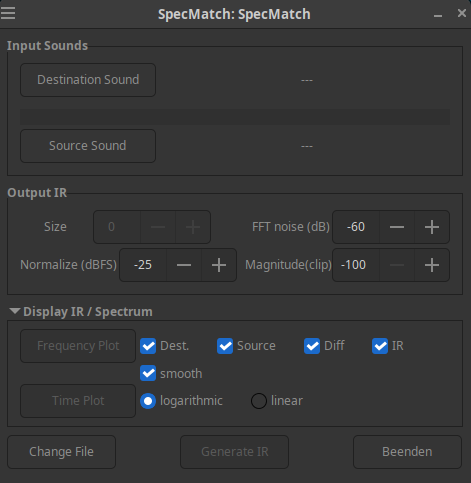Calculate an IR to match a spectrum
Project description
SpecMatch
A little Python 3 program to compare the spectrum of two sound files and generate a (smoothed) impulse response file (IR) from the spectral difference.

Dependencies
Installation
User installation (using pipx)
To install SpecMatch from PyPI for your user account, it is recommend to use pipx:
pipx install specmatch
This will install the specmatch package and all dependencies into an isolated
Python environment and a specmatch command into ~/.local/bin. Make sure
this directory is included in your PATH.
To uninstall the package and its pipx environment again, run:
pipx uninstall specmatch
System-wide installation (using pip)
To install SpecMatch system-wide instead run:
sudo pip install specmatch
Warning: This by-passes your distribution's package management and can
interfere with your Python system installation by overwriting Python packages
installed in your system with newer and potentially incompatible versions.
Therefor this method is not recommended and should only by used if you are
aware of and accept the risks involved. On some distributions, you may also
need to add the --break-system-packages option for this method to work at
all.
To uninstall the package, run:
sudo pip uninstall specmatch
Building from source (for packagers)
To build a wheel package, download and unpack the source distribution or clone the Git repository and change into the source directory. Make sure you have the Python build and installer packages installed and run:
python3 -m build --wheel
This will create a temporary Python environment, install the build dependencies
into it and build the wheel. If you want the build to use the system-installed
packages instead, use the --no-isolation option. In this case you also need
to make sure the Python package hatchling is installed, which is used as
a package building backend.
To install the wheel package, run:
python3 -m installer ./dist/specmatch-*.whl
You can use the --destdir option to set the root of the installation
destination to something other than /.
Running
When installed system-wide, SpecMatch can be started from your desktop
environment's menu. Alternatively, it can be started with the command
specmatch from the command line.

Without installation
SpecMatch can be used without installation directly from the source tree. Just go to the source folder and run:
python3 -m specmatch
When you run SpecMatch this way, you need to ensure that all dependencies are already available in your current Python environment.
Usage
SpecMatch works with project files (extension .specmatch). When first
started, a file selection window will appear were you need to choose a project
name. After that the SpecMatch Window will appear. On subsequent launches the
last selected project will be opened automatically. You can use the "Change
File" button to select another project file or create a new one (changes in
projects will be auto-saved).
Click on "Destination Sound". This is the sound file you want to match, and select a file. For stereo sounds, you can select one of the channels (or the sum) or produce a stereo IR.
Use "Source File" to select a other sound file. This is the sound you want to match to the destination.
Both files can have different sizes, it won't matter, since the program only compares the frequency spectra of the Files.
Now you can do a frequency plot of the source and the destination file. The plot also shows the differences and the resulting smoothed IR file. You can show a time plot as well.
To generate the IR file you set the normalisation level (default -25 dBFS), select the resulting IR file size (default 3500 samples) and select the noise level, i.e. the level below which the signal will be treated as noise (default -60 dB). Additionally it is possible to set the maximum magnitude difference, meaning the level below the maximum magnitude, where the minimum magnitude gets clipped (default -100dB).
You can generate a mono or a stereo IR-File.
When you press "Generate IR" a file browser will pop up and lets you choose the name and path where to save the generated IR file.
Author and License
SpecMatch was created by Hermann Meyer and is released under the MIT License. Please see the file LICENSE.md for details.
Project details
Release history Release notifications | RSS feed
Download files
Download the file for your platform. If you're not sure which to choose, learn more about installing packages.
Source Distribution
Built Distribution
File details
Details for the file specmatch-0.10.0.tar.gz.
File metadata
- Download URL: specmatch-0.10.0.tar.gz
- Upload date:
- Size: 16.7 kB
- Tags: Source
- Uploaded using Trusted Publishing? No
- Uploaded via: twine/5.0.1.dev0+g94f810c.d20240510 CPython/3.12.4
File hashes
| Algorithm | Hash digest | |
|---|---|---|
| SHA256 | 5b75e18035b7cc434fee2afd7ae866caf5d91f5caa6b962815385c8878e037bf |
|
| MD5 | b5934d5da9053d2478570ac4888e941f |
|
| BLAKE2b-256 | 0d41f28f5e14311de4dbcc4aa8eae0d474fe778c969a1a393e2863eb76204625 |
File details
Details for the file specmatch-0.10.0-py2.py3-none-any.whl.
File metadata
- Download URL: specmatch-0.10.0-py2.py3-none-any.whl
- Upload date:
- Size: 25.3 kB
- Tags: Python 2, Python 3
- Uploaded using Trusted Publishing? No
- Uploaded via: twine/5.0.1.dev0+g94f810c.d20240510 CPython/3.12.4
File hashes
| Algorithm | Hash digest | |
|---|---|---|
| SHA256 | a0035b5ae7d8b5fef6dcba36fa1472f7ed56163f139285e6a7a9309c201a7eed |
|
| MD5 | f64b8b12d6030e5644cba12f7837a891 |
|
| BLAKE2b-256 | e928f9387a053015648b89bcd6196e75bd8c3431726b2e298f34f549242d6084 |










